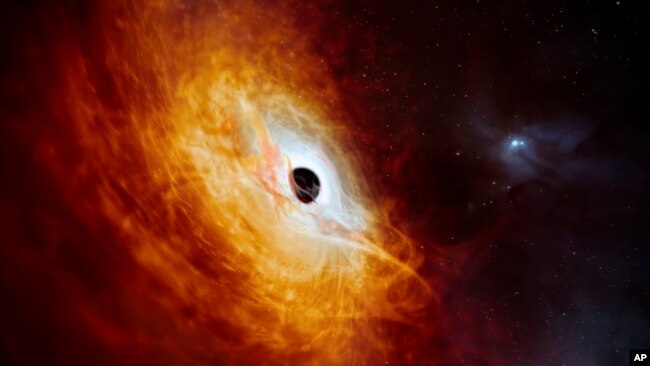새로 발견된 퀘이사는 우주에서 가장 밝은 물체일지도 모릅니다
Newly Discovered Quasar May Be Universe's Brightest Object
페이지 정보
작성자 By Associated Press 작성일 24-02-20 10:52 댓글 0본문

2024년 2월 유럽 남방 천문대가 제공한 이 그림은 초질량 블랙홀에 의해 구동되는 먼 은하의 밝은 핵인 기록적인 퀘이사 J059-4351을 보여줍니다.
This illustration provided by the European Southern Observatory in February 2024 depicts the record-breaking quasar J059-4351, the bright core of a distant galaxy that is powered by a supermassive black hole.
케이프 커내버럴, 플로리다 -
CAPE CANAVERAL, FLORIDA —
천문학자들은 우주에서 가장 밝은 물체가 무엇일지도 모른다는 것을 발견했습니다. 퀘이사의 중심부에 블랙홀이 너무 빨리 자라 하루에 태양과 같은 양을 삼킬 정도입니다.
Astronomers have discovered what may be the brightest object in the universe, a quasar with a black hole at its heart growing so fast that it swallows the equivalent of a sun a day.
이 기록적인 퀘이사는 우리 태양보다 500조 배나 더 밝습니다. 멀리 떨어진 퀘이사에 동력을 공급하는 블랙홀은 우리 태양보다 170억 배 이상 더 거대하다고 호주가 이끄는 연구팀이 월요일 네이처 천문학 저널에 보도했습니다.
The record-breaking quasar shines 500 trillion times brighter than our sun. The black hole powering this distant quasar is more than 17 billion times more immense than our sun, an Australian-led team reported Monday in the journal Nature Astronomy.
퀘이사가 이미지 속의 단순한 점을 닮았지만, 과학자들은 흉포한 장소를 상상합니다.
While the quasar resembles a mere dot in images, scientists envision a ferocious place.
퀘이사의 블랙홀 주위를 도는 회전하는 원반, 즉 별에서 나오는 빛나는 소용돌이의 가스와 다른 물질들은 우주 허리케인과 같습니다.
The rotating disk around the quasar's black hole — the luminous swirling gas and other matter from gobbled-up stars — is like a cosmic hurricane.
"이 퀘이사는 우리가 우주에서 알고 있는 가장 폭력적인 장소입니다," 라고 호주 국립 대학의 수석 저자인 크리스티안 울프가 이메일에서 말했습니다.
"This quasar is the most violent place that we know in the universe," lead author Christian Wolf of Australian National University said in an email.
유럽 남방 천문대는 1980년 하늘 조사에서 J0529-4351이라는 천체를 발견했지만, 그것은 별이라고 여겨졌습니다. 그것은 작년까지 은하계의 극도로 활동적이고 빛나는 중심핵인 퀘이사로 확인되지 않았습니다. 호주와 칠레의 아타카마 사막에서 망원경으로 관측한 결과, 그것이 발견되었습니다.
The European Southern Observatory spotted the object, J0529-4351, during a 1980 sky survey, but it was thought to be a star. It was not identified as a quasar — the extremely active and luminous core of a galaxy — until last year. Observations by telescopes in Australia and Chile's Atacama Desert clinched it.
"이 퀘이사의 흥미로운 점은 이 퀘이사가 잘 보이지 않는 곳에 숨어 있었고 이전에는 별로 잘못 분류되었다는 것입니다," 라고 연구에 참여하지 않은 예일 대학의 프리얌바다 나타라잔이 이메일에서 말했습니다.
"The exciting thing about this quasar is that it was hiding in plain sight and was misclassified as a star previously," Yale University's Priyamvada Natarajan, who was not involved in the study, said in an email.
이후의 관찰들과 컴퓨터 모델링은 이 퀘이사가 일년에 370 태양에 해당하는 양, 즉 하루에 하나씩 먹어 치우고 있다는 것을 밝혀냈습니다. 연구팀에 따르면, 추가적인 분석은 이 블랙홀의 질량이 우리 태양 질량의 170억에서 190억 배임을 보여줍니다. 이 블랙홀의 성장 속도를 이해하기 위해서는 더 많은 관찰이 필요합니다.
These later observations and computer modeling have determined that the quasar is gobbling up the equivalent of 370 suns a year — roughly one a day. Further analysis shows the mass of the black hole to be 17 to 19 billion times that of our sun, according to the team. More observations are needed to understand its growth rate.
이 퀘이사는 120억 광년 떨어져 있으며 우주 초기부터 존재해 왔습니다. 1광년은 5조 8천억 마일입니다.
The quasar is 12 billion light-years away and has been around since the early days of the universe. A light-year is 5.8 trillion miles.
출처 : VOANews
댓글목록 0
등록된 댓글이 없습니다.

















